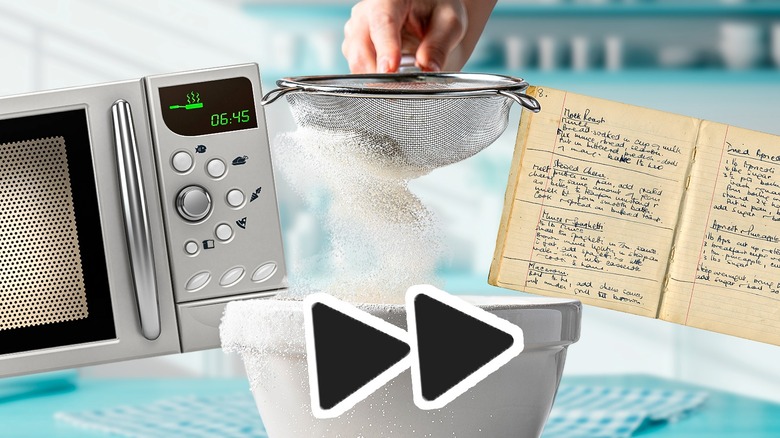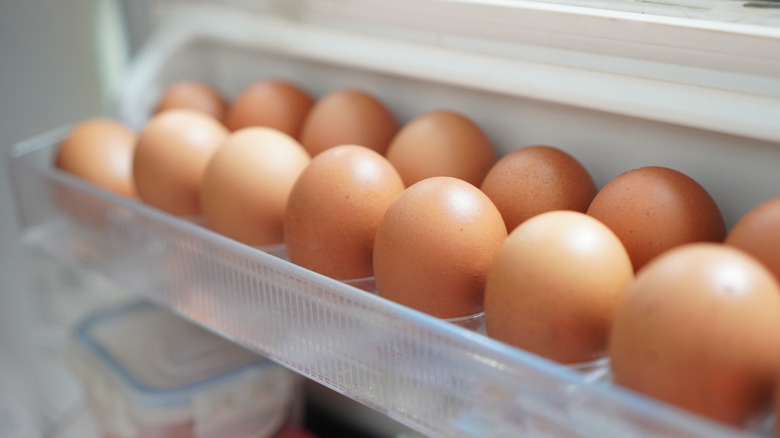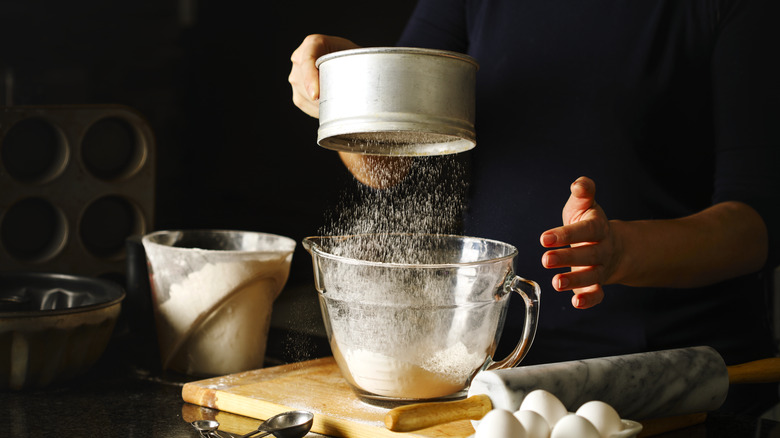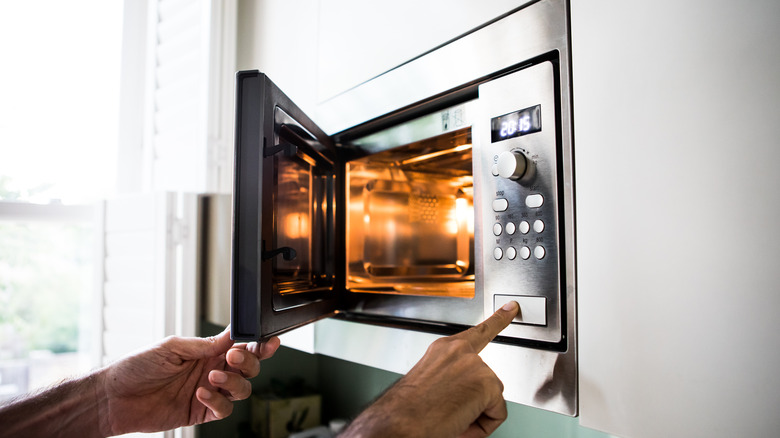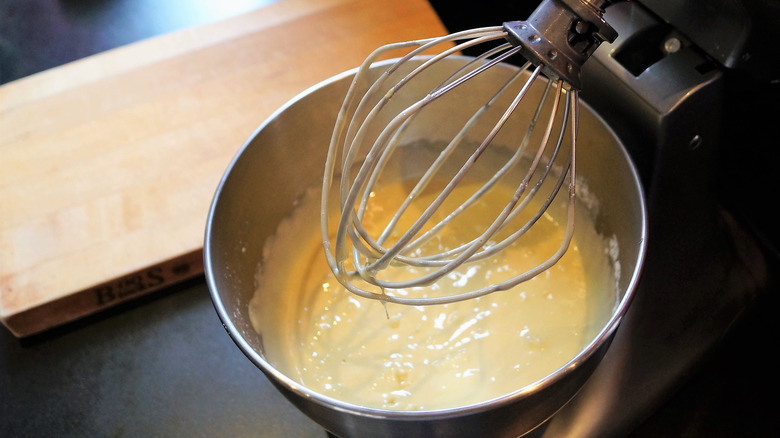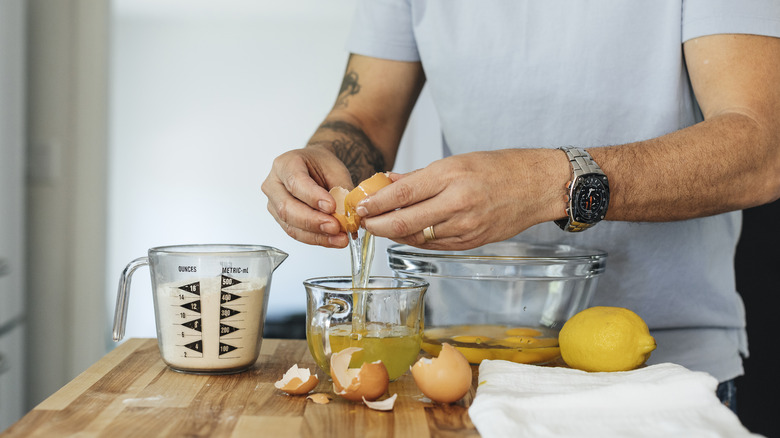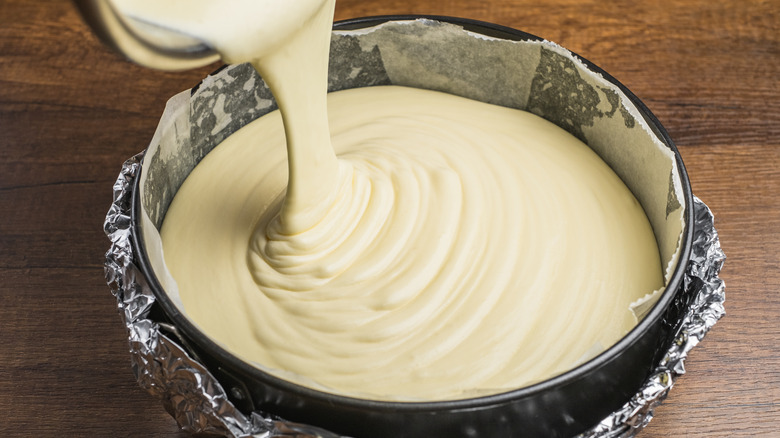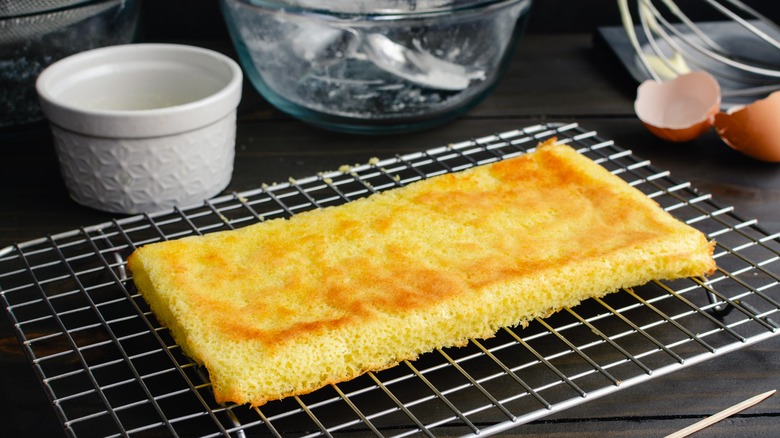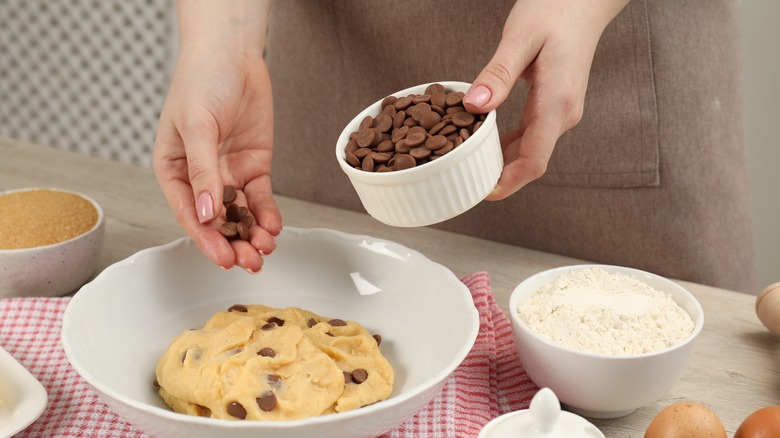Risky Baking Shortcuts That Are Not Worth Your Time
With the online world awash with culinary hacks, shortcuts, and quick-fix solutions, it's sometimes difficult to separate the worthwhile tips from the accident waiting to happen. To make things worse, while cooking invites experimentation, baking is allergic to the very concept.
As an expert, award-winning baker, I can confidently say that the act of baking cakes, cookies, and loaves of bread is more science than art. Chemistry, not artisanal flare, rules the day, and those tempted to tinker with the formula do so at their peril. Which is not to say that every tip and trick you stumble upon is a waste of time. Legitimate dessert and baking hacks exist. However, some shortcuts simply aren't worth the effort. Skipping steps that should not be skipped and ignoring tricks of the trade more often than not invite disaster.
Knowing where you can –- and cannot — cut corners often comes down to a matter of experience. When in doubt, relying on the hard-earned wisdom of others by following recipes to the letter almost always results in a good outcome. But if you're ever tempted to take shortcuts, take a look at this list (backed up by years of experience) of what not to do.
Using ingredients straight from the fridge
The application and control of heat is perhaps the most critical element of baking. Ovens need preheating, sugars must be taken to specific boiling points, and temperature must be carefully monitored at every stage. Still, all those adjustments assume there is a level playing field from the get-go. So one baking step that should never be ignored is the use of room-temperature ingredients, such as the eggs in your cookies and the butter in your batter.
Baking a cake relies on tried and tested techniques with one goal in mind: to mix the ingredients into a homogenous mass. Creaming together sugar with straight-from-the-fridge butter makes that blending a lot more difficult. The same is true of chilled eggs.
All that extra work means that you are left with two choices. Firstly, you can stop mixing before the batter is really finished, although doing so often results in an uneven, dry crumb peppered with overly moist spots. Secondly, you run the risk of overmixing the batter. Again, this produces less-than-ideal results. Folding in dry ingredients is all about incorporating air bubbles that help the raising agents within work their magic. Overmixing activates the gluten in the flour. The result is often a tough, dry cake.
Skipping the sift
Baking a cake tends to be a tale of two properties: the wet and the dry. Mixing the wet ingredients is often the more involved process of the two, while mixing the dry ingredients can sometimes feel like an afterthought. But treating it as such invites mishaps.
The reason so many recipes call for a sieve when adding flour is twofold. First, it's about accuracy. Flour is generally added by volume, not weight: hidden clumps within your measuring vessel run the risk of skewing the measurement. Adding too much flour creates a dry crumb that is prone to cracking; too little and the cake will be way too wet.
The second reason bakers sift flour is that doing so adds air, thus creating a lighter powder that is much easier to incorporate into the batter. Which is not to say that dry ingredients always need sifting. Many perfectly gooey cookie recipes eschew the process altogether, as do most loaves of bread and any number of cakes that err on the denser side of the equation. Still, as a rule, if a recipe calls for folding in the dry ingredients, it's asking for a light batter, and in such cases, it's definitely time to reach for the sifter. If you don't have a flour sifter, a fine mesh sieve works well as a substitute, or, failing that, agitating your dry mix with a balloon whisk also helps remove any lumps.
Microwave shortcuts
Baking a cake is always something of a marathon, with each stage punctuated by flurries of activity mixed in with lengthy periods of nothing to do but wait. The microwave is an ever-present ally here, offering some quick and easy shortcuts that streamline the process. Unfortunately — as many an aspiring baker learns, to their dismay — some of these time-saving measures are anything but. Take ganache, for example, a simple two-ingredient sauce (made with bittersweet chocolate and cream) that is perfect for drizzling over desserts, filling decadent macarons, or piping between layers of sponge cake.
There are two traditional methods of making a ganache. First, you can heat the cream on a stovetop and then pour it over the chocolate and mix until you create a smooth emulsion. Or you can melt the chocolate in a double boiler and then swirl in the cream. The popular shortcut of melting chocolate in the microwave is certainly quicker, but the chocolate burns surprisingly quickly, and when it does, it tends to become chalky and bitter. Heating cream in a microwave is also a bad idea as it tends to bubble over with little or no warning.
Nor does it end there. Hacks suggesting you can bring butter or other ingredients to room temperature via a quick blast of microwave cooking produce less-than-stellar results. Meanwhile, baking an actual cake in a microwave might take less than five minutes, but tends to make a rubbery, disappointing mess.
Throwing everything in and hitting mix
All-in-one cakes are all the rage these days. But, as with many online quick fixes, they are often not quite what they seem. Like one-pot pasta recipes, the idea is to throw everything in at once and begin to cook — or in the case of a cake batter, mix — immediately. It sounds like a much easier way of getting the job done with a minimum of fuss, but there's a catch. It doesn't work. Or at least, even in a best-case scenario, it doesn't work that well.
Throwing in the wet and dry ingredients together saves time but creates problems further down the line. The goal of making cake batter remains the same: you're trying to create a smooth, glossy, homogenous mix. However, the steps you skipped — the creaming of the sugar, the sifting of the flour, and the gradual addition of eggs — still need to occur, only now with interest. Getting the batter to the desired consistency requires a much longer mix, and all that extra time creates a tough, flat cake.
There is, after all, a reason wet and dry ingredients are mixed separately and then incorporated together. It's all about even distribution, adding air, and, crucially, mixing as little as possible. Even the raising agents themselves have to be fully incorporated. Failure to do so might result in clumps of oversaturated flour prone to an over-enthusiastic rise. The result? An uneven or potentially cracked sponge.
Eyeballing the ingredients
As any chef knows, tasting as you go is one of the most important parts of cooking. Your palate can check for seasoning, the balance of ingredients, and let you know if something needs a little more time to cook. Baking is different. Baking is chemistry.
Raw batter is not something you can check by taste, which makes it all the more important that you measure your ingredients precisely. To start with, it's not all that safe to eat; raw flour might be contaminated with E.coli, and raw eggs with salmonella. But even if the safety of taste-testing was not an issue, there are other reasons to avoid estimating measurements when it comes to baking.
Cakes are finicky things. As we have seen, too much flour produces dense cakes, while too little results in something akin to a wet mess. But other factors are critical also. Raising agents are measured in proportion to the volume of flour, eggs, sugar, and butter you are using. Self-rising flour takes out some of the legwork here, but even so, using precise measurements prevents most of the common baking disasters you are likely to encounter. Sure, some expert bakers tempt fate via slight adjustments made on the fly. However, such alterations are rarely anything more substantial than a minor tweak, and stem from years, if not decades of experience. For everyone else, the baking measurements listed in recipes are best followed to the letter.
Skipping the tap
There are steps taken during baking that seem interminable, and then there are those that take but a moment. It's easy to think of the latter as optional in your baking journey — but when it comes to the tap, you'd be very much mistaken. The tap is a simple enough concept to grasp. Once the cake batter is resting within the tin, simply raise it above the counter and then bring it back down with a moderate amount of force. This should be done several times, and you should rotate the tin as you go. This smack-and-spin technique provides two important benefits to the finished product. Firstly, it levels out the cake. This cuts out the need to slice uneven surfaces away post-bake, which takes time, patience, and skill.
The tap also removes any lingering air bubbles. The time and effort put into aerating the cake is about creating soluble air trapped within the batter. Doing so keeps things light, which in turn helps the raising agents do their thing. Large pockets of air, however, create an effect known as tunnelling, meaning that your cake might have a Swiss cheese look to it, a bubbled surface, or an unsightly –- and difficult to decorate around — bulge.
Care needs to be taken when performing the tap. While those on a quest to create the perfect brownie will be pleased to know that a literal slam about fifteen minutes into the baking process helps create a denser, fudgier brownie, the lighter the cake you are making, the more gentle you need to be with the tap.
Skipping the chill
The fact that temperature is a critical component of the baking process pretty much goes without saying, but there is as flip side to all that heat: cakes also need time to chill. There are two principal moments in baking where things need cooling down. The first of these happens before cooking. Many cookie doughs needs to chill for at least thirty minutes before baking, and some people advocate leaving sugar cookie dough in the fridge overnight for even more consistent results. The chill prevents cookies from spreading out too much during baking. The base of a cheesecake also needs a certain rigidity. Regardless of the type of cheesecake you are making, chilling the base for at least an hour provides a smooth surface to rest the cream cheese mixture upon.
Still, the need to chill post-bake is, if anything, an even more crucial step. Traditional cakes are left on a wire rack to cool for good reason. Hot cakes are delicate and hard to handle, while frosting refuses to stick and any attempt to apply a ganache is going to result in a melted mess.
Meanwhile, cheesecake demands even more attention in the cooling-off period. Turning the oven off and cracking the door open allows a cheesecake to lose heat gradually, something that prevents the custard from cracking. Even once it has dropped down to room temperature, you need to resist the urge to dive in. For best results, a cheesecake should always be left in the fridge – never the freezer – to chill overnight.
Adding drop-in ingredients without flouring them first
Many recipes call for dropping things into the batter shortly before baking. Such items range from dried fruit to nuts, berries, and, of course, chocolate chips. The problem with doing so is that the most dropped-in goodies are generally denser than the cake batter itself. Consequently, they have a tendency to sink to the bottom and stay there. The solution is to flour such items before adding them.
The flour has a dual effect. First, it helps absorb any excess moisture, making each item that little bit less slippery. Second it provides texture, something for the batter to cling onto as the drop-in ingredients lie suspended within.
A light dusting is all that is needed — adding too much might alter the flour ratio of the whole cake with regrettable results. Once coated, carefully drop each item in one by one, rotating the bowl as you do so, then give the whole thing a gentle stir in order to create a more or less even distribution.
Reading the recipe as you go
As crimes against baking go, failure to read a recipe in advance is up there as one of the worst. Recipes often have surprises deep within the text, and while it's tempting to plow forward as soon as you read the first ingredient, chances are you'll run into a snag before the end.
Most recipes start with a list of ingredients, and checking that you have everything you need, or making a shopping list, is usually everyone's first stop. Once everything has been gathered together, the next stage involves turning the oven on and preheating it to a specific temperature. Calibrating your oven is of great help here.
After those steps have been completed, you enter something of a culinary wild west. Baking a cheesecake is a notable example. Early instructions — such as the need to use room-temperature cream cheese — can create a bottleneck if you begin weighing out the sugar while the cream cheese is still in the fridge. Worse, if you fail to read to the end, you might find that the cheesecake you just prepared for tonight's dinner party won't be ready until the following day.
Taking your time to read the whole recipe avoids any of the nasty surprises an unfamiliar recipe can throw at you. Armed with all the pertinent information you need — and mindful of some of the pitfalls detailed above — chances are, things will turn out exactly as you planned.
